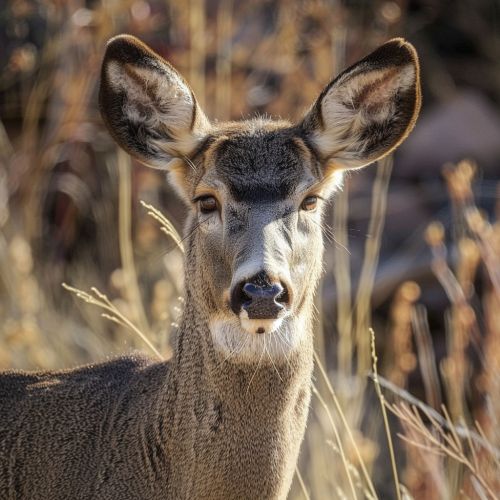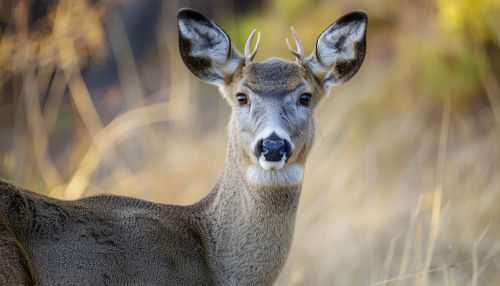Mule deer
Taxonomy and Evolution
The mule deer (Odocoileus hemionus) is a species of deer indigenous to western North America. It is named for its ears, which are large like those of the mule. The several subspecies include the black-tailed deer.
Unlike its cousin, the white-tailed deer (Odocoileus virginianus), mule deer are generally more associated with the land west of the Missouri River, and more specifically with the Rocky Mountain region of North America. The most noticeable differences between whitetails and mule deer are the size of their ears, the color of their tails, and the configuration of their antlers. The mule deer's tail is black-tipped, whereas the whitetail's is not. Mule deer antlers are bifurcated; they "fork" as they grow, rather than branching from a single main beam, as is the case with whitetails.


Description
Mule deer are easy to identify due to their large mule-like ears (generally 3/4 the length of the head). They usually weigh between 55 and 150 kg (120 to 330 lb), although males may weigh up to 210 kg (460 lb). The shoulder height ranges from 0.6 to 1.0 m (2.0 to 3.3 ft). Unlike the related white-tailed deer, which have a reddish-brown summer coat, mule deer are generally more gray in color. Another distinguishing feature of the mule deer is its tail, which is white with a black tip.
Behavior
Mule deer are known for their unique bounding leap (stotting) that they use when startled, in which all four feet come off the ground simultaneously. This gait can be maintained at speeds up to 14 mph for males and 18 mph for females. They are also good swimmers and often enter water to escape predators or to eat aquatic plants.
Mule deer are primarily browsers, with a majority of their diet comprised of forbs (weeds) and browse (leaves and twigs of woody shrubs). They are ruminants, like cows, and regurgitate their food and chew it as cud. They have a four-chambered stomach that allows them to eat a variety of different foods, digesting them in a series of steps.
Reproduction
Mule deer are a polygynous species, with males competing for the attention of females during the rut, or mating season. Males will often fight each other using their antlers to establish dominance and secure a mate. Females, or does, usually give birth to two fawns, although single births are not uncommon. Fawns are born in the spring and are weaned in the fall, at which point they often form sibling groups that stay together over the winter.
Conservation Status
The mule deer is currently classified as a species of least concern by the IUCN, due to its wide distribution and presumed large populations. However, the species' population numbers are declining due to habitat loss, predation, and hunting. Conservation efforts are focused on maintaining population numbers and preserving habitat.
